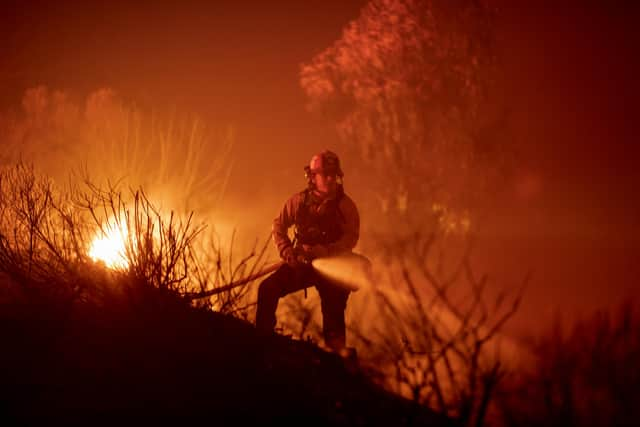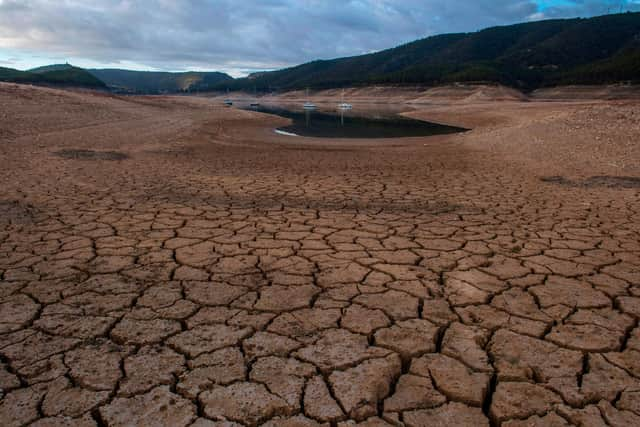COP26 climate change summit: World is acting too slowly on global warming – Royal Society, US National Academy of Sciences and South African Academy of Science
It is time to accelerate the pace of the decarbonisation of the global economy to ensure we have a planet fit for future generations, with no one left behind.
In August, the Intergovernmental Panel on Climate Change (IPCC) concluded that unless there are immediate, rapid, large-scale reductions in greenhouse gas emissions, limiting global warming to 1.5C or even 2C will be beyond reach.
Advertisement
Hide AdAdvertisement
Hide AdAt 2C of global warming, the IPCC warned, heat extremes would more often reach critical tolerance thresholds for agriculture and health. We are already seeing the effects of droughts, wildfires, extreme weather events, flooding and extreme heat.
Examples pepper news reports from all over the world, and if we do not implement ambitious targets and transition to equitable pathways to net-zero carbon dioxide quickly, the frequency and severity of these events will increase.
Even as we struggle with the pandemic, climate change is an urgent threat we cannot afford to ignore. As we approach COP26 in Glasgow, the current pace of decarbonisation of our global economy is too slow, and the challenge for global leaders at the upcoming summit is to set a marker down for greater ambition and faster action.
The action required is the responsibility of us all – governments, industry, civil society and each of us as individuals. Achieving net zero requires a whole-system approach across all nations and across all sectors of the economy and society, recognising countries’ varying starting points.


For decades, scientific evidence has been showing us the scale of the problem. Now science is providing solutions. We already have some critical tools. Low-carbon technologies such as renewable electricity generation are already commonplace in our lives, but they need to be deployed faster and more widely.
But existing technologies alone will not deliver net zero, so we need to invest in, and speed development of, the next generation of ideas. That is particularly true of hard-to-decarbonise sectors like shipping and aviation, steel and cement manufacture, and food production.
The feasibility of renewable electricity depends on storage solutions from batteries to larger-scale, longer-term storage. Chemical storage of energy such as hydrogen and ammonia show promise and can also help deliver energy in other areas such as transport. We will need new types of low-carbon, sustainable fuel, including synthetic fuels. We have to develop new industrial processes to tackle the huge output of greenhouse gases from making steel, cement, and chemicals.
Agriculture, forestry and other land use are responsible for around 25 per cent of emissions. We need new ways to provide nutrition and forestry that sequester more carbon than they release. Agriculture is not only driving emissions, but its expansion is also responsible for much biodiversity loss. Sustainable intensification of farming, improved soil management and nature-based solutions to mitigate the effects of climate change are all achievable.


Advertisement
Hide AdAdvertisement
Hide AdNo matter what emissions cuts we make, we will also have to adapt to some degree of global warming. Many impacts are being felt now, and more are unavoidable. Many countries are not yet sufficiently resilient to events like heatwaves and floods. Poorer countries will be less able to adapt and will need support.
We need to keep expanding our understanding of climate change and its impacts. The better we understand how a warming world will impact lives, the better we can prepare.
There is no one-size-fits-all solution. Every nation will have to chart its own just solution as part of a global approach. Each government should develop an evidence-based technology roadmap suited to their nation’s needs. These roadmaps will need to be informed by science, engineering, and economics, and they must be fluid enough to adapt to new knowledge and changing circumstances.
These roadmaps can give confidence for public and private sector investment at the national and international scale. Plans should be open and transparent to allow the greatest possible international cooperation and support, with sharing of knowledge and resources.


It will also be essential for richer nations to work together to support middle and low-income countries. Support in the form of finance, technology, and capacity building is crucial to support policy packages to shift to climate-resilient and low-emissions development pathways. Priority should also be given to reducing poverty and inequality, and importantly, ensuring access to affordable, reliable, and sustainable energy for everyone.
All of these things are achievable. There can be no excuses, because the consequences of failure are too great.
The power of science has been brought into sharp focus in the past 18 months as we faced a global pandemic. The speed at which we learned to understand the virus – a virus that no one had heard of two years ago – was spectacular.
Scientists all over the world have worked around the clock to sequence the genome of the virus and produce safe, effective vaccines and treatments. The toll of the pandemic has been huge, but without science it would have been much worse.
Advertisement
Hide AdAdvertisement
Hide AdWe now need to turn that focus on the battle against climate change. We already have a number of feasible, affordable solutions and there are plenty more in the pipeline. What we need now is the political will and leadership to deliver change through policy and investment.
Jonathan Jansen, president of the South African Academy of Science; Marcia McNutt, president of the US National Academy of Sciences; Adrian Smith, president of the UK’s Royal Society
A message from the Editor:
Thank you for reading this article. We're more reliant on your support than ever as the shift in consumer habits brought about by coronavirus impacts our advertisers.
If you haven't already, please consider supporting our trusted, fact-checked journalism by taking out a digital subscription.
Comments
Want to join the conversation? Please or to comment on this article.
